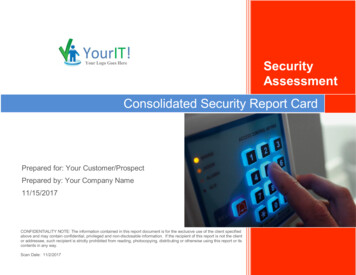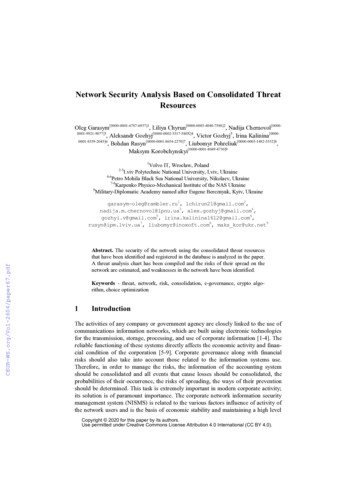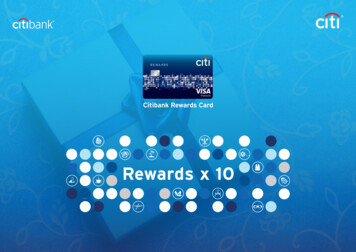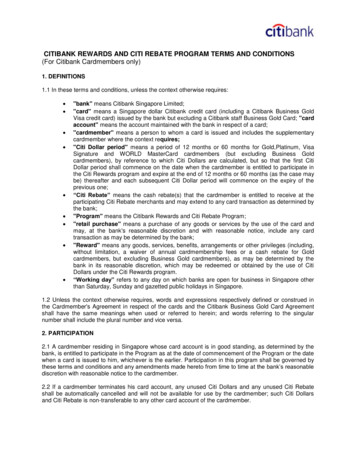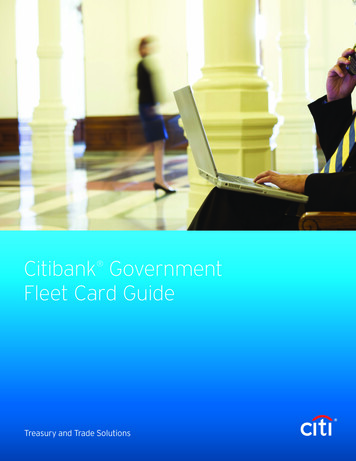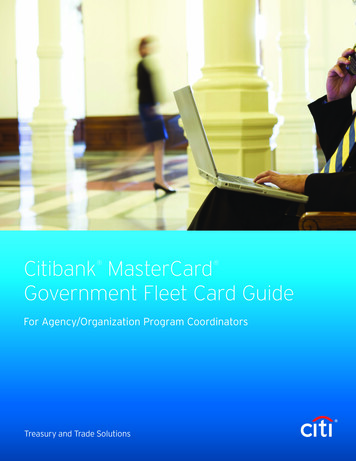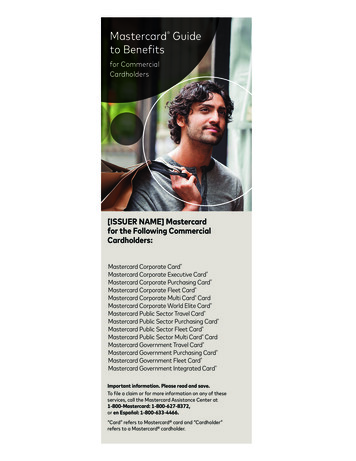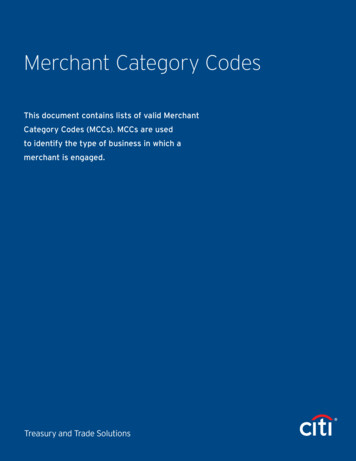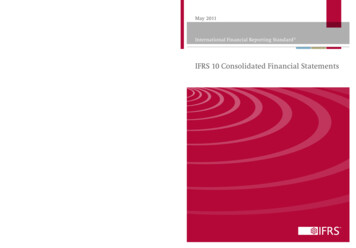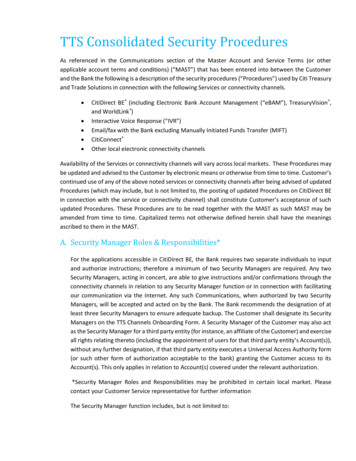
Transcription
TTS Consolidated Security ProceduresAs referenced in the Communications section of the Master Account and Service Terms (or otherapplicable account terms and conditions) (“MAST”) that has been entered into between the Customerand the Bank the following is a description of the security procedures (“Procedures”) used by Citi Treasuryand Trade Solutions in connection with the following Services or connectivity channels. CitiDirect BE (including Electronic Bank Account Management (“eBAM”), TreasuryVision ,and WorldLink )Interactive Voice Response (“IVR”)Email/fax with the Bank excluding Manually Initiated Funds Transfer (MIFT)CitiConnect Other local electronic connectivity channelsAvailability of the Services or connectivity channels will vary across local markets. These Procedures maybe updated and advised to the Customer by electronic means or otherwise from time to time. Customer’scontinued use of any of the above noted services or connectivity channels after being advised of updatedProcedures (which may include, but is not limited to, the posting of updated Procedures on CitiDirect BEin connection with the service or connectivity channel) shall constitute Customer’s acceptance of suchupdated Procedures. These Procedures are to be read together with the MAST as such MAST may beamended from time to time. Capitalized terms not otherwise defined herein shall have the meaningsascribed to them in the MAST.A. Security Manager Roles & Responsibilities*For the applications accessible in CitiDirect BE, the Bank requires two separate individuals to inputand authorize instructions; therefore a minimum of two Security Managers are required. Any twoSecurity Managers, acting in concert, are able to give instructions and/or confirmations through theconnectivity channels in relation to any Security Manager function or in connection with facilitatingour communication via the Internet. Any such Communications, when authorized by two SecurityManagers, will be accepted and acted on by the Bank. The Bank recommends the designation of atleast three Security Managers to ensure adequate backup. The Customer shall designate its SecurityManagers on the TTS Channels Onboarding Form. A Security Manager of the Customer may also actas the Security Manager for a third party entity (for instance, an affiliate of the Customer) and exerciseall rights relating thereto (including the appointment of users for that third party entity’s Account(s)),without any further designation, if that third party entity executes a Universal Access Authority form(or such other form of authorization acceptable to the bank) granting the Customer access to itsAccount(s). This only applies in relation to Account(s) covered under the relevant authorization.*Security Manager Roles and Responsibilities may be prohibited in certain local market. Pleasecontact your Customer Service representative for further informationThe Security Manager function includes, but is not limited to:
1. Establishing and maintaining the access and entitlements of users (including the SecurityManagers themselves), including activities such as:(a) creating, deleting or modifying User Profiles (including Security Manager Profiles) andentitlement rights (please note that user name must align with supporting identificationdocuments)(b) building access profiles that define the functions and data available to various users, and(c) enabling and disabling user log-on credentials2. Creating and modifying entries in Customer maintained libraries (such as preformatted paymentsand beneficiary libraries) and authorizing other users to do the same3. Modifying payment authorization flows4. Allocating dynamic password credentials or other system access credentials or passwords to theCustomer’s users5. Notifying the Bank if there is any reason to suspect that security has been compromised.Security Managers also assign transaction limits to users for those Bank products to which theCustomer has access. These limits are not monitored or validated by the Bank; Customer shouldmonitor these limits to ensure in compliance with Customer’s internal policies and requirements,including but not limited to, those established by Customer’s Board of Directors or equivalent.Specifically related to the eBAM Application, the following roles are required:The initial setup on the eBAM Service requires the designation of three Security Officers and oneCorporate Secretary. Two separate Senior Administrative Roles act in concert as maker/checker toset up and assign User function/data entitlements and Workflows. These arrangements are notmonitored or validated by Bank; Workflows and User activity are monitored by the Customer toensure compliance with Customer’s (and Account Owners’) internal policies, requirements, andauthorization and approval levels, including but not limited to those established by the Customer’s(and Account Owners’) Board of Directors or equivalent governing body.The following roles are required for the eBAM Service:1. Security Officer: fulfills functions described in (1) a-c above within the roles of Security Managers2. Corporate Secretary: ensures that Workflows, Users set up as Designated Authorizers, and theirassignment to Workflows meet internal policies, requirements, authorization and approval levels,as established by the Customer’s (and Account Owners’) Board of Directors or equivalentgoverning authority3. Designated Authorizer: have broad, senior authority to initiate and authorize Workflow activities4. Request Initiators: are individuals authorized to perform administrative activities such asentering account and signer management requests into the eBAM systemThe Security Officers, Corporate Secretary, and Designated Authorizers are responsible for:a) Defining and administering hierarchy setup and site/flow control, such as establishing Workflowsand identifying Users and levels of approvalb) Creating additional Senior Administrative Roles and appointing Users thereto (who may or maynot be employed by the Customer)
c) Notifying Bank if there is any reason to suspect that security or confidentiality of any User(including Senior Administrative Roles) credentials has been breached or compromisedd) Where relevant, completing, amending, approving and/or supplementing such Customerimplementation forms as may be reasonably requested by Bank from time to time in connectionwith the provision of services and/or products to CustomerB. Authentication MethodsThe Procedures include certain secure authentication methods (“Authentication Methods”) whichare used to uniquely identify and verify the authority of the Customer and/or any of its users typicallythrough mechanisms such as User ID / password pairs, digital certificates, and security tokens(deployed via hardware or software) which generate a dynamic password used to access the servicesor connectivity channels each time the Customer or a user logs in or authenticates themselves. Pleasenote that availability of the Authentication Methods described below varies based on local markets.Security Managers and all users who want to (a) initiate or approve transactions (and whose UserProfile permits them to do so) and/or (b) access the systems in accordance with entitlements mustuse the available Authentication Methods (which may be updated from time to time as describedabove).The following Authentication Methods are available to access the above-noted services orconnectivity channels in combination with a User ID:Authentication MethodDescriptionToken: Challenge ResponseEither a (i) mobile application based soft token (e.g. MobilePASS) or (ii) physical token(e.g. SafeWord Card, Vasco) which in each case is used to generate a dynamicpassword after authenticating with a 4 digit pin. When accessing CitiDirect BE, thesystem generates a challenge, and a response passcode is generated by the utilizedtoken and entered into the system.Token: One-Time PasswordEither a (i) mobile application based soft token (e.g. MobilePASS) or (ii) physical token(e.g. SafeWord Card, Vasco) which is used to generate a dynamic password afterauthenticating with a 4 digit pin. This dynamic password is entered into the system togain access.SMS One-Time CodeA dynamic password is delivered to a user via SMS, after which the user enters thedynamic password and a secure password to gain access to the systemVoice One-Time CodeA dynamic password is delivered to a user via an automated voice call, after which theuser enters the dynamic password and a secure password to gain access to the systemMultiFactor AuthenticationA dynamic password is generated via a SafeWord Card or MobilePASS token, afterwhich such dynamic password is entered along with a secure password to gain accessto the system.Digital CertificatesA Digital Certificate issued by an approved certificate authority which is used forauthentication. Digital Certificates utilize a Key Storage Mechanism and acorresponding PIN, and may be issued by IdenTrust, SWIFT (3SKey) or other agreedupon providers.
Secure PasswordA user enters their secure password to access the system. A Secure Password typicallylimits a user’s capabilities on the system, such that information can be viewed and notransaction capabilities are enabled.Interactive Voice Response(“IVR”) & emailUsers contacting the bank will be prompted to enter a PIN number or provide otherinformation to validate authorized access over the phone or over email.FaxCorrespondence received by the Bank, excluding MIFT requests, will be signatureverified based on the information that is contained in the Customer’s boardresolution.MTLSMandatory Transport Layer Security (MTLS) creates a secure, private emailconnection between the bank and the external party. An email transmitted sent usingthis channel is sent over the Internet through an encrypted TLS tunnel created by theconnection.Secure PDFEncrypted emails are delivered to a regular mailbox as a PDF Document that is openedby entering a private password, both the message body and any attached files areencrypted. A private password can be set up upon receipt of the first Secure Emailreceived.To learn more about any of these Authentication Methods, please refer to the Login Help page onCitiDirect BE : s/loginHelp.pser)For CitiConnect If the Customer chooses to use a public Internet connection to connect to Citi, including HTTPS,secure FTP, and FTPS, the Bank and the Customer will exchange security certificates to ensureboth the communication channel and the messages exchanged are fully encrypted and protected.The Bank will only accept Communications originating from the Customer’s securedcommunications gateway using the exchanged security certificates, and vice versa, and the Bankwill only transmit Communications to the Customer’s communication gateway using theexchanged security certificates.If the Customer chooses to use CitiConnect via SWIFT, then for any payment orders andinstructions involving SWIFT, including amending or cancelling such orders, the Procedures thatwill be used to authenticate that a payment order or instruction is that of the Customer andauthorized by the Customer shall be those as provided for in the SWIFT ContractualDocumentation (as such term is defined by SWIFT and as may be amended or supplemented fromtime to time) which includes without limitation its General Terms and Conditions and FIN ServiceDescription or as set forth in any other terms and conditions that may be established by SWIFT.The Bank is not responsible for any errors or delays in the SWIFT system. Communications to theBank are to be provided in the format and type required and specified by SWIFT.If using a VPN, both the Customer and the Bank will designate a single IP address from whichCommunications between the Customer and Bank will be sent and/or received. The Bank will onlyaccept Communications originating from the Customer’s designated IP address, and vice versa,and the Bank will only transmit Communications to the Customer’s designated IP address, andvice versa.
The Customer and the Bank may also use a Hardware Security Module Authentication toaccompany VPN Authentication. This requires the Bank and the Customer each to install a deviceon the servers designated for Communications between the Bank and the Customer.The Bank requires: Customer’s safeguarding of the Authentication Methods including any log-on credentials and/orsecurity certificates associated with the Authentication Methods (collectively, the “Credentials”)and ensuring that access to and distribution of the Credentials are limited only to authorizedpersons of the Customer. The Authentication Methods and associated Credentials are themethods by which the Bank verifies the origin of Communications issued by the Customer to theBank.The Customer should take all reasonable steps to protect the Credentials. Accordingly, the Bankstrongly recommends that the Customer does not share the Credentials with any third party.Certain jurisdictions may require individuals (and their corresponding credentials) to be identified ascompliant with applicable AML legislation requirements before granting access to perform certainfunctions.The Bank understands that the Customer may, in some cases, wish to share the Customer’sCredentials with a third party entity or service provider (including without limitation any third partypayroll provider) designated by the Customer to have access to the Customer’s Credentials (such thirdparty entity or service provider shall be referred to herein as an “Authorized Third Party”) for thepurpose of accessing and utilizing any of the banks electronic channels on the Customer’s behalf. Inthe event that the Customer elects to share its Credentials with an Authorized Third Party, the Bankstrongly recommends that the Customer takes, and ensure that any Authorized Third Party takes, allreasonable steps to protect the Credentials from being disclosed to any non-Authorized Third Partypersonnel. The Bank is authorized to act upon any Communication that it receives from an AuthorizedThird Party on behalf of the Customer in compliance with these Procedures.C. Data Integrity and Secured Communications The Customer will be transmitting data to and otherwise exchanging Communications with theBank, utilizing the Internet, email and/or fax, which are not necessarily secure communicationand delivery systems. The Bank, utilizes industry leading encryption methods (as determined bythe Bank), which help to ensure that information is kept confidential and that it is not changedduring transit.If the Customer suspects or becomes aware of, a technical failure or any improper access to oruse of the Bank’s services, connectivity channels or the Authentication Methods by any person(whether an authorized person or not), the Customer shall promptly notify the Bank of suchoccurrence. In the event of improper access or use by an authorized person, the Customer shouldtake immediate actions to terminate such authorized person's access to and use of the Bank’sservices or connectivity channels.If Customer utilizes file formatting, encryption software (whether provided by the Bank or a thirdparty), to support the formatting and recognition of the Customer’s data and instructions and
acts upon Communications with Citi, then the Customer will use such software solely for thepurpose for which it has been installed.The Customer accepts that the Bank may suspend the access of the Users to the Services thatrequire the use of the Credentials (i) in case of suspicion of unauthorized or fraudulent use of theCredentials and/or (ii) in order to safeguard the Services and/or Credentials.
TTS Consolidated Security Procedures . Security Managers, acting in concert, are able to give instructions and/or confirmations through the . Profile permits them to do so) and/or (b) access the systems in accordance with entitlements must use the available Authentication Met
